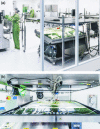Moss-made pharmaceuticals: from bench to bedside
- PMID: 26011014
- PMCID: PMC4736463
- DOI: 10.1111/pbi.12401
Moss-made pharmaceuticals: from bench to bedside
Abstract
Over the past two decades, the moss Physcomitrella patens has been developed from scratch to a model species in basic research and in biotechnology. A fully sequenced genome, outstanding possibilities for precise genome-engineering via homologous recombination (knockout moss), a certified GMP production in moss bioreactors, successful upscaling to 500 L wave reactors, excellent homogeneity of protein glycosylation, remarkable batch-to-batch stability and a safe cryopreservation for master cell banking are some of the key features of the moss system. Several human proteins are being produced in this system as potential biopharmaceuticals. Among the products are tumour-directed monoclonal antibodies with enhanced antibody-dependent cytotoxicity (ADCC), vascular endothelial growth factor (VEGF), complement factor H (FH), keratinocyte growth factor (FGF7/KGF), epidermal growth factor (EGF), hepatocyte growth factor (HGF), asialo-erythropoietin (asialo-EPO, AEPO), alpha-galactosidase (aGal) and beta-glucocerebrosidase (GBA). Further, an Env-derived multi-epitope HIV protein as a candidate vaccine was produced, and first steps for a metabolic engineering of P. patens have been made. Some of the recombinant biopharmaceuticals from moss bioreactors are not only similar to those produced in mammalian systems such as CHO cells, but are of superior quality (biobetters). The first moss-made pharmaceutical, aGal to treat Morbus Fabry, is in clinical trials.
Keywords: ADCC; Morbus Fabry; Physcomitrella patens; biobetter; knockout moss; moss bioreactor.
© 2015 The Authors. Plant Biotechnology Journal published by Society for Experimental Biology and The Association of Applied Biologists and John Wiley & Sons Ltd.
Figures

References
-
- Anterola, A. , Shanle, E. , Perroud, P.‐F. and Quatrano, R. (2009) Production of taxa‐4(5),11(12)‐diene by transgenic Physcomitrella patens . Transgenic Res. 18, 655–660. - PubMed
-
- Baird, R.D. , Tan, D.S.P. and Kaye, S.B. (2010) Weekly paclitaxel in the treatment of recurrent ovarian cancer. Nat. Rev. Clin. Oncol. 7, 575–582. - PubMed
-
- Baur, A. , Reski, R. and Gorr, G. (2005a) Enhanced recovery of a secreted recombinant human growth factor using stabilizing additives and by co‐expression of human serum albumin in the moss Physcomitrella patens . Plant Biotechnol. J. 3, 331–340. - PubMed
-
- Baur, A. , Kaufmann, F. , Rolli, H. , Weise, A. , Luethje, R. , Berg, B. , Braun, M. , Baeumer, W. , Kietzmann, M. , Reski, R. and Gorr, G. (2005b) A fast and flexible PEG‐mediated transient expression system in plants for high level expression of secreted recombinant proteins. J. Biotechnol. 119, 332–342. - PubMed
-
- Beck, M. (2010) Emerging drugs for lysosomal storage diseases. Expert Opin. Emerg. Drugs 15, 495–507. - PubMed
Publication types
MeSH terms
Substances
LinkOut - more resources
Full Text Sources
Other Literature Sources
Medical
Research Materials
Miscellaneous

